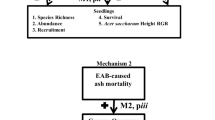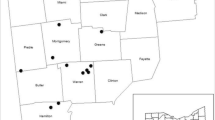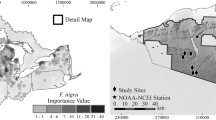Abstract
Emerald ash borer (EAB) (Agrilus planipennis Fairmaire), an invasive forest insect first identified in southeastern Michigan in 2002, is established in at least 32 US states and three Canadian provinces. Ash (Fraxinus spp.) mortality rates in some forested areas exceed 90%, but to date, little is known about the potential effects of EAB-caused ash mortality on hydrological processes. More broadly, there is a need for information on the timing and magnitude of soil moisture response to species-specific mortality of overstory vegetation in deciduous forest systems. Soil moisture was examined in 28 forested sites where 0–100% of the white ash basal area (Fraxinus americana L.) was killed by EAB. Synoptic measurements of near-surface (0–6 cm depth) soil moisture were collected from 112 plots (18 m radius) within the sites. Three plots were also instrumented with soil moisture sensors at 10 and 25 cm depth to log hourly measurements from May to October. Synoptic data showing white ash mortality and soil moisture were positively correlated in the 34 plots with ≥ 5% mortality (by total basal area). In the intensively monitored plots, volumetric soil moisture declined from 37 to 16% between July and September where white ash mortality was low (0.6% of basal area killed), but remained near field capacity (~ 30%) throughout the monitoring period in the high mortality plot (8.6% of basal area killed), meriting further investigation to assess effects of white ash mortality on evapotranspiration and soil moisture dynamics in heterogeneous upland forests. Altered soil moisture may have implications for regrowth dynamics, infiltration/runoff partitioning, and nutrient cycling, but additional study to quantify the extent and duration of EAB-related ash mortality on hydrology at the plot and watershed scale is necessary.





Similar content being viewed by others
References
Anulewicz AC, McCullough DG, Cappaert DL (2007) Emerald Ash Borer (Agrilus planipennis) density and canopy dieback in three North American ash species. Arboric Urban For 33:338–349
Anulewicz AC, McCullough DG, Cappaert DL, Poland TM (2008) Host range of the emerald ash borer (Agrilus planipennis Fairmaire) (Coleoptera: Buprestidae) in North America: results of multiple-choice field experiments. Environ Entomol 37:230–241 (doi:10.1603/0046-225X(2008)37[230:HROTEA]2.0.CO;2)
Apple BA, Reeves HW (2007) Summary of hydrogeologic conditions by County for the State of Michigan (USGS Open-File Report No. 2007–1236)
Biederman JA, Brooks PD, Harpold AA et al (2014a) Multiscale observations of snow accumulation and peak snowpack following widespread, insect-induced lodgepole pine mortality. Ecohydrol 7:150–162. https://doi.org/10.1002/eco.1342
Biederman JA, Harpold AA, Gochis DJ et al (2014b) Increased evaporation following widespread tree mortality limits streamflow response. Water Resour Res 50:5395–5409. https://doi.org/10.1002/2013WR014994
Biederman JA, Somor AJ, Harpold AA et al (2015) Recent tree die-off has little effect on streamflow in contrast to expected increases from historical studies. Water Resour Res 51:9775–9789. https://doi.org/10.1002/2015WR017401
Bosch JM, Hewlett JD (1982) A review of catchment experiments to determine the effect of vegetation changes on water yield and evapotranspiration. J Hydrol 55:3–23. https://doi.org/10.1016/0022-1694(82)90117-2
Burr SJ, McCullough DG (2014) Condition of green ash (Fraxinus pennsylvanica) overstory and regeneration at three stages of the emerald ash borer invasion wave. Can J For Res 44:768–776. https://doi.org/10.1139/cjfr-2013-0415
Cappaert D, McCullough DG, Poland TM, Siegert NW (2005) Emerald ash borer in North America: a research and regulatory challenge. Am Entomol 51:152–165
Clapp RB, Hornberger GM (1978) Empirical equations for some soil hydraulic properties. Water Resour Res 14:601–604. https://doi.org/10.1029/WR014i004p00601
Clow DW, Rhoades C, Briggs J et al (2011) Responses of soil and water chemistry to mountain pine beetle induced tree mortality in Grand County, Colorado, USA. Appl Geochem 26(Supplement):S174–S178. https://doi.org/10.1016/j.apgeochem.2011.03.096
COSEWIC (2014) COSEWIC Assessment and Status Report on the Blue Ash Fraxinus quadrangulata in Canada - Species at Risk Public Registry. http://www.registrelep-sararegistry.gc.ca/document/default_e.cfm?documentID=2766. Accessed Aug 2017
Decagon 5TM User’s Manual. [n.d.] Available at http://www.decagon.eu/education/5tm-manual/. Accessed Jan 2015
Dunne T, Leopold LB (1978) Water in environmental planning. Macmillan, Basingstoke
EAB.info [Emerald Ash Borer Information] [n.d.]. http://www.emeraldashborer.info. Accessed Aug 2017
Ebel BA, Mirus BB (2014) Disturbance hydrology: challenges and opportunities: invited commentary. Hydrol Process 28:5140–5148. https://doi.org/10.1002/hyp.10256
Farrand WR, Bell DL (1982) Quaternary geology of Michigan (map). Michigan Department of Natural Resources-Geological Survey
Fissore C, McFadden JP, Nelson KC et al (2012) Potential impacts of emerald ash borer invasion on biogeochemical and water cycling in residential landscapes across a metropolitan region. Urban Ecosyst 15:1015–1030. https://doi.org/10.1007/s11252-012-0239-2
Flower CE, Knight KS, Gonzalez-Meler MA (2012) Impacts of the emerald ash borer (Agrilus planipennis Fairmaire) induced ash (Fraxinus spp.) mortality on forest carbon cycling and successional dynamics in the eastern United States. Biol Invasions 15:931–944. https://doi.org/10.1007/s10530-012-0341-7
Flower CE, Knight KS, Rebbeck J, Gonzalez-Meler MA (2013) The relationship between the emerald ash borer (Agrilus planipennis) and ash (Fraxinus spp.) tree decline: using visual canopy condition assessments and leaf isotope measurements to assess pest damage. For Ecol Manag 303:143–147. https://doi.org/10.1016/j.foreco.2013.04.017
Gandhi KJK, Herms DA (2010) Direct and indirect effects of alien insect herbivores on ecological processes and interactions in forests of eastern North America. Biol Invasions 12:389–405. https://doi.org/10.1007/s10530-009-9627-9
Gesch DB, Oimoen M, Greenlee S, Nelson C, Steuck M, Tyler D (2002) The national elevation dataset. Photogramm Eng Remote Sens 68:1
Groundwater Inventory and Mapping Project (GWMAP) & Well View [n.d.]. http://gwmap.rsgis.msu.edu/. Accessed Jan 2016
Herms DA, McCullough DG (2014) Emerald ash borer invasion of North America: History, biology, ecology, impacts, and management. Annu Rev Entomol 59:13–30. https://doi.org/10.1146/annurev-ento-011613-162051
Hillel D (1980) Fundamentals of soil physics. Academic Press, Cambridge
Klooster WS, Herms DA, Knight KS et al (2014) Ash (Fraxinus spp.) mortality, regeneration, and seed bank dynamics in mixed hardwood forests following invasion by emerald ash borer (Agrilus planipennis). Biol Invasions 16:859–873. https://doi.org/10.1007/s10530-013-0543-7
Knight KS, Brown JP, Long RP (2013) Factors affecting the survival of ash (Fraxinus spp.) trees infested by emerald ash borer (Agrilus planipennis). Biol Invasions 15:371–383. https://doi.org/10.1007/s10530-012-0292-z
Kovacs KF, Mercader RJ, Haight RG et al (2011) The influence of satellite populations of emerald ash borer on projected economic costs in US communities, 2010–2020. J Environ Manag 92:2170–2181. https://doi.org/10.1016/j.jenvman.2011.03.043
Livneh B, Deems JS, Buma B et al (2015) Catchment response to bark beetle outbreak and dust-on-snow in the Colorado Rocky Mountains. J Hydrol 523:196–210. https://doi.org/10.1016/j.jhydrol.2015.01.039
Loheide IISP. (2008) A method for estimating subdaily evapotranspiration of shallow groundwater using diurnal water table fluctuations. Ecohydrol 1:59–66. https://doi.org/10.1002/eco.7
McCullough DG, Mercader RJ (2012) Evaluation of potential strategies to SLow Ash Mortality (SLAM) caused by emerald ash borer (Agrilus planipennis): SLAM in an urban forest. Int J Pest Manag 58:9–23. https://doi.org/10.1080/09670874.2011.637138
McCullough DG, Mercader RJ, Siegert NW (2015) Developing and integrating tactics to slow ash (Oleaceae) mortality caused by emerald ash borer (Coleoptera: Buprestidae). Can Entomol 147:349–358. https://doi.org/10.4039/tce.2015.3
Mercader RJ, Siegert NW, Liebhold AM, McCullough DG (2011a) Simulating the effectiveness of three potential management options to slow the spread of emerald ash borer (Agrilus planipennis) populations in localized outlier sites. Can J For Res 41:254–264. https://doi.org/10.1139/X10-201
Mercader RJ, Siegert NW, Liebhold AM, McCullough DG (2011b) Influence of foraging behavior and host spatial distribution on the localized spread of the emerald ash borer, Agrilus planipennis. Popul Ecol 53:271–285. https://doi.org/10.1007/s10144-010-0233-6
Mercader RJ, Siegert NW, McCullough DG (2012) Estimating the influence of population density and dispersal behavior on the ability to detect and monitor agrilus planipennis (Coleoptera: Buprestidae) populations. J Econ Entomol 105(1):272–281
Millar DJ, Ewers BE, Mackay DS, Peckham S, Reed DE, Sekoni A (2017) Improving ecosystem-scale modeling of evapotranspiration using ecological mechanisms that account for compensatory responses following disturbance. Water Resour Res 53 (9):7853–7868. https://doi.org/10.1002/2017WR020823
Mikkelson KM, Bearup LA, Maxwell RM et al (2013) Bark beetle infestation impacts on nutrient cycling, water quality and interdependent hydrological effects. Biogeochemistry 115:1–21. https://doi.org/10.1007/s10533-013-9875-8
Nachabe M, Shah N, Ross M, Vomacka J (2005) Evapotranspiration of two vegetation covers in a shallow water table environment. Soil Sci Soc Am J 69:492–499
NOAA National Weather Service. http://www.weather.gov/. Accessed 1 Sep 2016
Peel MC, Finlayson BL, McMahon TA (2007) Updated world map of the Köppen-Geiger climate classification. Hydrol Earth Sys Sci 11(5):1633–1644. https://doi.org/10.5194/hess-11-1633-2007
Penn CA, Bearup LA, Maxwell RM, Clow DW (2016) Numerical experiments to explain multiscale hydrological responses to mountain pine beetle tree mortality in a headwater watershed. Water Resour Res 52(4):3143–3161. https://doi.org/10.1002/2015WR018300
Poland TM, McCullough DG (2006) Emerald ash borer: invasion of the urban forest and the threat to North America’s ash resource. J For 2006:118–124
Pugh E, Gordon E (2013) A conceptual model of water yield effects from beetle-induced tree death in snow-dominated lodgepole pine forests. Hydrol Process 27:2048–2060. https://doi.org/10.1002/hyp.9312
Pugh SA, Liebhold AM, Morin RS (2011) Changes in ash tree demography associated with emerald ash borer invasion, indicated by regional forest inventory data from the Great Lakes States. Can J For Res 41:2165–2175. https://doi.org/10.1139/x11-138
Raymond P, Munson AD, Ruel J-C, Coates KD (2006) Spatial patterns of soil microclimate, light, regeneration, and growth within silvicultural gaps of mixed tolerant hardwood—white pine stands. Can J For Res 36:639–651. https://doi.org/10.1139/x05-269
Rebek EJ, Herms DA, Smitley DR (2008) Interspecific variation in resistance to emerald ash borer (Coleoptera: Buprestidae) among North American and Asian ash (Fraxinus spp.). Environ Entomol 37:242–246 (doi:10.1603/0046-225X(2008)37[242:IVIRTE]2.0.CO;2)
Ritter E, Dalsgaard L, Einhorn KS (2005) Light, temperature and soil moisture regimes following gap formation in a semi-natural beech-dominated forest in Denmark. For Ecol Manage 206:15–33. https://doi.org/10.1016/j.foreco.2004.08.011
Saxton KE, Rawls WJ (2006) Soil water characteristic estimates by texture and organic matter for hydrologic solutions. Soil Sci Soc Am J 70(5):1569–1578. https://doi.org/10.2136/sssaj2005.0117
Scharenbroch BC, Bockheim JG (2007) Impacts of forest gaps on soil properties and processes in old growth northern hardwood-hemlock forests. Plant Soil 294:219–233. https://doi.org/10.1007/s11104-007-9248-y
Schlesinger RC (1990) Fraxinus americana L. White ash. Silvics of North America, Volume 2, Hardwoods. USDA Forest Service, Sidney pp 333–338
Siegert NW, McCullough DG, Williams DW, Fraser I, Poland TM, Pierce SJ (2010) Dispersal of (Coleoptera: Buprestidae) From discrete epicenters in two outlier sites. Environ Entomol 39(2):253–265
Siegert NW, McCullough DG, Liebhold AM, Telewski FW (2014) Dendrochronological reconstruction of the epicentre and early spread of emerald ash borer in North America. Divers Distrib 20:847–858. https://doi.org/10.1111/ddi.12212
Slesak RA, Lenhart CF, Brooks KN et al (2014) Water table response to harvesting and simulated emerald ash borer mortality in black ash wetlands in Minnesota, USA. Can J For Res 44:961–968. https://doi.org/10.1139/cjfr-2014-0111
Smith A, Herms DA, Long RP, Gandhi KJK (2015) Community composition and structure had no effect on forest susceptibility to invasion by the emerald ash borer (Coleoptera: Buprestidae). Can Entomol 147:318–328. https://doi.org/10.4039/tce.2015.8
Soil Survey Staff Web Soil Survey. US Department of Agriculture, Washington. http://websoilsurvey.sc.egov.usda.gov/App/HomePage.htm
Stednick JD (1996a) Monitoring the effects of timber harvest on annual water yield. J Hydrol 176:79–95. https://doi.org/10.1016/0022-1694(95)02780-7
Tanis SR, McCullough DG (2012) Differential persistence of blue ash and white ash following emerald ash borer invasion. Canadian J Forest Res 42(8):1542–1550
Tanis SR, Mccullough DG (2015) Host Resistance of five Fraxinus species to Agrilus planipennis (Coleoptera: Buprestidae) and effects of paclobutrazol and fertilization. Environ Entomol 44(2):287–299. https://doi.org/10.1093/ee/nvu005
Telander AC, Slesak RA, D’Amato AW et al (2015) Sap flow of black ash in wetland forests of northern Minnesota, USA: hydrologic implications of tree mortality due to emerald ash borer. Agric For Meteorol 206:4–11. https://doi.org/10.1016/j.agrformet.2015.02.019
Villari C, Herms DA, Whitehill JGA et al (2016) Progress and gaps in understanding mechanisms of ash tree resistance to emerald ash borer, a model for wood-boring insects that kill angiosperms. New Phytol 209:63–79. https://doi.org/10.1111/nph.13604
Wagner DL, Todd KJ (2016) New ecological assessment for the emerald ash borer: a cautionary tale about unvetted host-plant literature. Am Entomol 62:26–35. https://doi.org/10.1093/ae/tmw005
Zarnoch SJ, Bechtold WA, Stolte KW (2004) Using crown condition variables as indicators of forest health. Can J For Res 34:1057–1070. https://doi.org/10.1139/x03-277
Acknowledgements
We thank Brian Martell and Alyssa Wethington, both of Michigan State University (MSU), and Jasmine Stefansky, Mike Wessenberg, John Goodin (Central Michigan University), and Jason Barnes for their assistance in the field. We appreciate the access to study sites provided by the Michigan Dept. of Natural Resources, the Huron-Metro Park Association, and Eaton County. This work was funded by Grants to DGM from the USDA Forest Service, Northeastern Area, State and Private Forestry.
Author information
Authors and Affiliations
Corresponding author
Rights and permissions
About this article
Cite this article
Robertson, W.M., Robinett, M. & McCullough, D.G. Soil moisture response to white ash mortality following emerald ash borer invasion. Environ Earth Sci 77, 356 (2018). https://doi.org/10.1007/s12665-018-7525-0
Received:
Accepted:
Published:
DOI: https://doi.org/10.1007/s12665-018-7525-0




